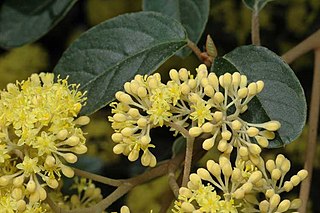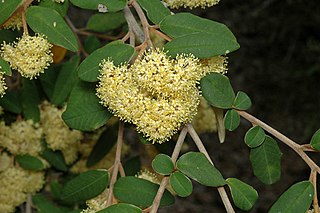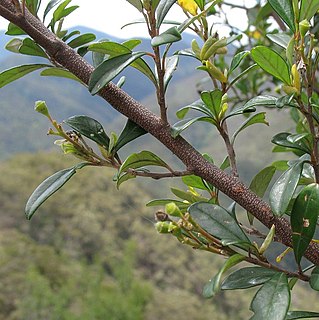
Pomaderris aspera, commonly known as hazel pomaderris, is a species of flowering plant in the family Rhamnaceae and is endemic to south-eastern Australia. It is a shrub or small tree with elliptic to lance-shaped or egg-shaped leaves and greenish-yellow flowers.

Pomaderris ferruginea, commonly known as rusty pomaderris, is a species of flowering plant in the family Rhamnaceae and is endemic to south-eastern continental Australia. It is a shrub with rusty-hairy stems, egg-shaped leaves, and clusters of cream-coloured, whitish or yellow flowers.

Pomaderris elliptica, commonly known as yellow dogwood or smooth pomaderris, is a species of flowering plant in the family Rhamnaceae and is endemic to south-eastern Australia. It is a shrub with densely hairy branchlets, egg-shaped or elliptic leaves, and pale yellow flowerss.

Pomaderris mediora is a species of flowering plant in the family Rhamnaceae and is endemic to the central coast of New South Wales. It is a low-lying or erect shrub with hairy new growth, narrowly elliptic to lance-shaped leaves with the narrower end towards the base, and panicles of cream-coloured flowers.

Pomaderris argyrophylla, commonly known as silver pomaderris, is a species of flowering plant in the family Rhamnaceae and is endemic to north-eastern Australia. It is a shrub or small tree with lance-shaped leaves and white to cream-coloured or yellow flowers.

Pomaderris bodalla, commonly known as Bodalla pomaderris, is a species of flowering plant in the family Rhamnaceae and is endemic to New South Wales. It is a shrub with hairy young stems, elliptic to more or less rhombic leaves, and dense clusters of cream-coloured flowers.

Pomaderris brevifolia is a species of flowering plant in the family Rhamnaceae and is endemic to the south of Western Australia. It is a slender shrub with silky-hairy young branchlets, wedge-shaped, heart-shaped or egg-shaped leaves with the narrower end towards the base, and clusters of ten to twenty cream-coloured to pale pink flowers.
Pomaderris buchanensis is a species of flowering plant in the family Rhamnaceae and is endemic to Victoria, Australia. It is a shrub with densely hairy young stems, narrowly egg-shaped or lance-shaped leaves, and panicles of pale greenish or yellowish flowers.
Pomaderris clivicola is a species of flowering plant in the family Rhamnaceae and is endemic to a restricted area of Queensland. It is a multi-stemmed shrub with softly-hairy twigs, egg-shaped leaves, and small panicles of yellow to cream-coloured flowers.

Pomaderris cocoparrana, commonly known as Cocoparra pomaderris, is a species of flowering plant in the family Rhamnaceae and is endemic to a restricted area of New South Wales. It is a shrub with hairy stems, egg-shaped to more or less round leaves, and clusters of yellow flowers.
Pomaderris coomingalensis is a species of flowering plant in the family Rhamnaceae and is endemic to Queensland. It is a shrub with hairy young stems, egg-shaped or elliptic leaves, and clusters of cream-coloured or yellow flowers.

Pomaderris costata is a species of flowering plant in the family Rhamnaceae and is endemic to south-eastern continental Australia. It is a spreading shrub with densely hairy branchlets, egg-shaped to elliptic leaves, and panicles of cream-coloured or white flowers.

Pomaderris cotoneaster, commonly known as cotoneaster pomaderris, is a species of flowering plant in the family Rhamnaceae and is endemic to south-eastern continental Australia. It is an erect shrub with woolly-hairy stems, elliptic leaves, and leafy panicles of cream-coloured flowers.
Pomaderris crassifolia is a species of flowering plant in the family Rhamnaceae and is endemic to eastern Australia. It is a shrub with hairy young stems, egg-shaped or elliptic leaves, and clusters of cream-coloured or yellow flowers.
Pomaderris forrestiana is a species of flowering plant in the family Rhamnaceae and is endemic to south-western Australia. It is a low shrub with elliptic leaves, and small clusters of woolly-hairy flowers.

Pomaderris gilmourii is a species of flowering plant in the family Rhamnaceae and is endemic to Deua National Park in New South Wales. It is a shrub with hairy young stems, egg-shaped to elliptic leaves, and clusters of silvery buds and creamy-yellow flowers.
Pomaderris graniticola is a species of flowering plant in the family Rhamnaceae and is endemic to eastern Australia. It is a shrub or small tree with hairy young stems, lance-shaped to elliptic leaves, and sparse panicles of yellow, white or cream-coloured flowers.
Pomaderris halmaturina, commonly known as Kangaroo Island pomaderris, is a species of flowering plant in the family Rhamnaceae and is endemic to southern continental Australia. It is a shrub with narrowly elliptic to egg-shaped leaves with toothed or wavy edges, and sparse panicles of hairy, yellowish-green flowers.

Pomaderris ledifolia, commonly known as Sydney pomaderris, is a species of flowering plant in the family Rhamnaceae and is endemic to south-eastern continental Australia. It is an erect, delicate shrub with hairy young stems, narrowly elliptic to lance-shaped leaves, and compact clusters of yellow flowers.

Pomaderris ligustrina, commonly known as privet pomaderris, is a species of flowering plant in the family Rhamnaceae and is endemic to south-eastern continental Australia. It is a shrub with hairy stems, lance-shaped to narrowly elliptic leaves, and loose clusters of cream-coloured or yellow flowers.













